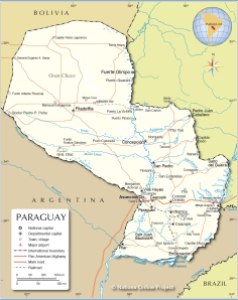For general information about the country profiles click here.
 Population: 6,6802,295
Population: 6,6802,295
HDI ranking: 111
HDI score: 0.676
Latin American countries are known for their high level of decentralization. However, Paraguay is one of the most centralized countries in the region, due to a perceived threat to national sovereignty and its generally low density.
Local governance at a glance
- Paraguay is divided into 17 departments and 231 municipalities. Citizens directly elect their mayor. A proportional representation system is used to elect the councilors (UCLG, 2008).
- At the national level, the National Audit Office and the National Congress oversee local government (UCLG, 2008).
- There are gender quotas at the subnational level: “Parties are required to have internal party mechanisms to ensure that 1 in every 5 candidates in the parties and movement primaries list should be a woman” (Quota Project, 2013).
Civil society actors
- The Center for Judicial Studies (CEJ) is committed to improving the judicial system in Paraguay, increasing citizen participation and promoting effective access to justice (CEJ, 2014).
- The Center for Information and Resources for Development (CIRD) works to mobilize the civil society to better manage resources and share information in order to promote social progress and social justice throughout Paraguay (CIRD, 2006).
- Seeds for Democracy (Semillas) promotes citizens participation and the responsible exercise of government to improve the overall quality of democracy in Paraguay. They work alongside organizations and institutions responsible for developing policies and laws in order to ensure that these laws and policies support democratic practices and initiatives (Semillas, n.d.).
Capacity building institutions
- The Paraguayan Intermunicipal Cooperation Organization (OPACI) formed in 1971 with the purpose of promoting cooperation between municipalities and strengthening local governments (OPACI, 2014).
- The Board of Governors was created in the 1990s to act as a platform for governors to discuss local issues and plans for the future. This board exists as a subset of the Ministry of Exterior Relations (MER, 2014).
Fiscal control
- Local Governments expenditures are reportedly around 1.8 percent of the total GDP, or roughly 7 percent of the total government spending (UCLG, 2010).
- Some components of local budgets need to be approved by higher level authorities in the central or regional levels (UCLG, 2010).
- There is almost no restriction on local borrowing (UCLG, 2010).
Key initiatives for participatory local governance
- The first article of the new democratic constitution in 1992 defined Paraguay as a ‘decentralized’ nation (UCLG, 2008).
- In 1991, municipalities directly elected mayors for the first time after a new electoral code was reinstated (UCLG, 2008).
- Some municipalities have begun introducing participatory budgeting to include citizens in the financial decision making process (UCLG, 2008).
- The World Bank acknowledges Paraguay’s successes in granting free access to primary health care and basic education to all citizens (World Bank, 2013).
Challenges for participatory local governance
- The government has had trouble working with small budgets to implement successful projects and build effective public institutions (UN, 2004).
- Insufficient accountability mechanisms have been an inherent challenge to implementing policies and projects (UN, 2004).
- Municipalities are still controlled by the central government despite their legal autonomy and the progress toward democratisation since 1991 (UCLG, 2008).
Recent posts on this website about this country:
______________________
List of sources :
Center for Information and Resources for Development (CIRD), 2006: http://www.cird.org.py/.
Center for Judicial Studies (CEJ), 2014: http://www.cej.org.py/index.php/cej.
Ministry of External Relations (MER), 2014: http://www.mre.gov.py/v1/Contenidos/222-autoridadesNacionales.aspx#Gobernadores.
Paraguayan Intermunicipal Cooperation Organization (OPACI), 2014: http://www.opaci.org.py/.
Seeds for Democracy (Semillas), n.d.: http://www.semillas.org.py/.
Quota Project, 2013: “Paraguay.”
United Cities and Local Governments (UCLG), 2008: “Paraguay Country Profile.”
United Cities and Local Governments (UCLG), 2010: “Local Government Finance: The Challenges of the 21st Century.”
United Nations (UN), 2004: “Paraguay: Overview of achievements and challenges promoting gender equality and women’s empowerment.”
World Bank, 2013: “Paraguay Overview.”
